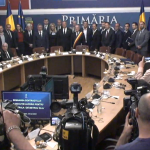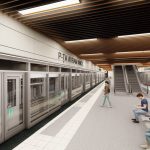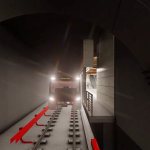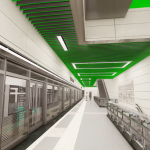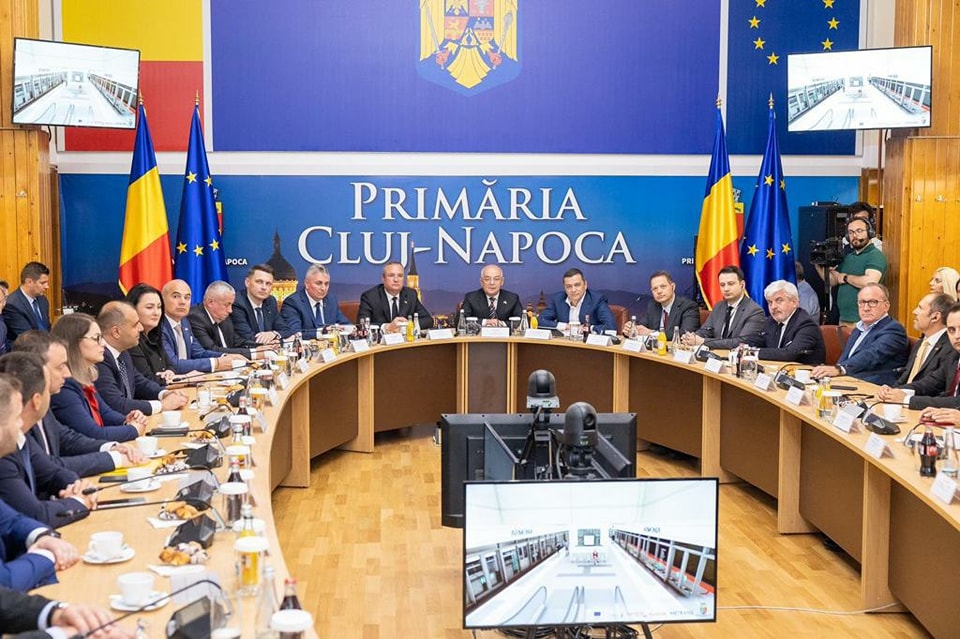
The representatives of the consortium of Gulermak, Alstom and Arcada signed the contract for the construction of Cluj-Napoca Metro Line 1 on May 25, 2023, expected to be completed within 96 months.
Romania’s Prime Minister Nicolae Ciucă, the Ministrer of Transport and Infrastructure, Sorin Grindeanu, and the Minister of Internal Affairs, Lucian Bode, as well as the Mayor of Cluj-Napoca, Emil Boc, and the Mayor of Florești commune Bogdan Nicolae Pivariu, attended the event which marks a new era for city’s public transport system.
The project has a value of more than RON 9 billion, without VAT, (EUR 1.8 billion) and is financed through the Romania’s recovery and resilience plan with RON 1.5 billion (EUR 302.6 million). RON 8.67 billion (EUR 1.7 billion) is the value of construction works while RON 398 million (EUR 80.3 million) is the value for design works which includes studies, technical expertise and documentation necessary to obtain approvals, agreements and authorisations.
The contract has been signed for the first phase of the project covering the construction of a 9.16 km line with 9 stations from Sfânta Maria to Europa Unită and an above-ground depot.
“It is city’s first such massive infrastructure project which will have a great impact on sustainable transport. Cluj-Napoca is the second Romanian city to benefit metro system and we are glad to support local authorities to implement this important project for the community. The project is the result of a great collaboration between the government and local authorities, and I want to highlight the necessity to promote such a partnership in the benefir of citizens,” the Prime Minister said.
Under its share of EUR 400 million, Alstom will be responsible for the system integration, signalling and telecommunication, power supply and track work, platform doors, security and control centre, as well as implementing proven cybersecurity throughout the system. Alstom will deploy the CBTC supporting the highest grade of automation 4 (GoA4) for the first time in Romania, using its high-capacity CBTC signalling solution Urbalis.
“It’s the largest transport infrastructure project in city’s history, totalling EUR 2.2 billion. More than 70,000 cars daily made their journey on the Cluj – Floresti route, and today, the traffic has significantly increased. Along this axis, metro development is the single viable solution to reduce road congestion,” Emil Boc said.
Cluj-Napoca Metro Line 1 is part of city’s transport strategy covering a system of 21 km with 19 stations. The line will be split into two branches one towards Muncii Boulevard and the other, to Europa Unită station. The project is estimated at EUR 2.2 billion. “Works for the first phase must be completed in August 2026 when we plan to start the construction for the second phase which will be financed by the Ministry of Transport and Infrastructure,” Sorin Grindeanu said at the signing ceremony. The second phase covers the construction of 12 km and 10 stations, split into the 8.8 km Țara Moților (in Florești) – Sfânta Maria section to be served by seven stations and the 3 km Piața Mărăști – Muncii section with three stations. The metro system will serve Cluj-Napoca city and Florești commune in its metropolitan area and is expected to be completed in 8 years. Cluj-Napoca Metro will be Romania’s first fully automated metro line with a high-capacity service at 90 seconds headways, providing west-east connection as well as a connection to the future metropolitan train system.
In 2031, when the metro system will be fully in operation, 164,000 passengers each day removing 29,000 cars in the city. The line will be operated by 40 trains per hour per direction.
In 2019, the City Municipality and six communes have signed an agreement to develop a feasibility study on the metro system, and one year later, a EUR 7.4 million contract has been signed with a consortium of SWS Engineering, Systra and Metrans Engineering to deliver the feasibility studies for Cluj metro system and the suburban train network.
Share on:




